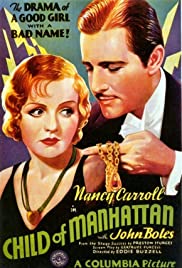
CHILD OF MANHATTAN
US, 1933, 70 minutes, Black and white.
Nancy Carroll, John Boles, Buck Jones, Jessie Ralph, Jane Darwell, Betty Grable, Nat Pendleton.
Directed by Edward Buzzell.
A classic film of the early 1930s. Pre-Code?. It is more open in situation and dialogue than the prescriptions of the Motion Picture Code.
The film is an adaptation of a stage play from Broadway by playwright and later screenwriter and director, Preston Sturges (Hail be Conquering Hero, Miracle of Morgan’s Creek…). The film has a rather solemn title. In fact, the child, is a hostess at a 10 cents a dance Dance Hall, called Love Land.
She is Madeleine, played with enormous verve by Nancy Carroll. Her Irish mother is played by Jane Darwell, later to win an Oscar for The Grapes of Wrath. There is a brief glimpse of Madeleine’s sister played by Betty Grable.
John Bowles, always solemn, plays Paul Vanderkiller, a wealthy New Yorker who inherited his money from his great-grandfather, from farms sold for the establishment of Manhattan. So, he too is a child of Manhattan. His prim aunt is suspicious about the Dance Hall, especially suspecting that nude women cavort there. He goes to inspect, encounters Madeleine, falls for her, gives her money, buys her lavish clothes and gifts, invites her to be his mistress. With some reservations, she accepts, dismissed by her mother and brother.
While things seem idyllic, she becomes pregnant, not wanting to pin Paul down. When the baby dies, she decides to disappear after Paul had offered to marry her. She goes to Mexico for a divorce, accompanied by the German lady who supervise the girls at the dance hall, the first film for comedian, Jessie Ralph, who makes quite an impression. In Mexico, she encounters the owner of a silver mine, Buck Jones, who had previously proposed to her at the dance hall.
The lawyer who organises her divorce adds a huge alimony clause which disturbs Paul who has been searching for her. When Madeleine discovers the clause, she decides that she should marry the prospector even though she does not love him and he is aware of this.
Just as the wedding is to proceed, Paul arrives from New York, Madeleine admitting her love for him, the prospector overhearing – and a happy ending with a re-marriage.
The relationship between Madeleine and Paul is made quite explicit in the dialogue, something not so explicit in later films, such as the variation of the theme with Stella Dallas (which also starred John Boles).
(Contemporary sensitivities: At the end, Jessie Ralph refers to ‘the coloured man in the woodpile’.)